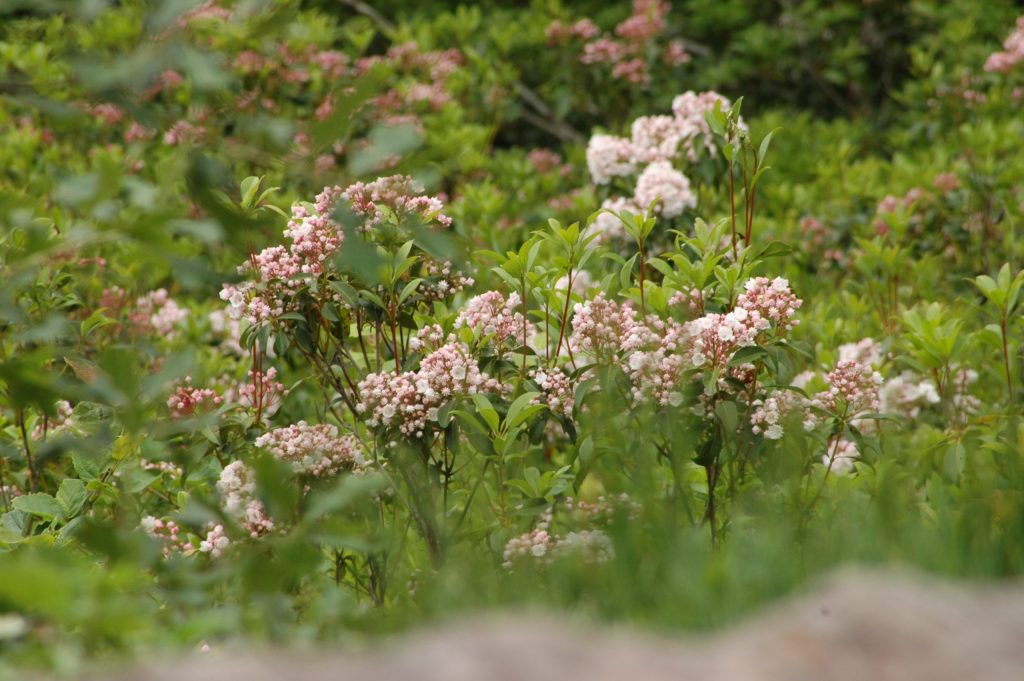Mountain laurel (Kalmia latifolia) is Pennsylvania’s State Flower. And anyone who has tried to walk through a stand of it knows it’s faster to walk the half a mile around it than the tenth of a mile through it.
A member of the heath family (Ericaceae), its cousins include rhododendron, blueberry, huckleberry, and azalea. Family reunions usually take place on acidic, infertile soils.
These plants survive under these conditions because they have thick, “waxy” leaves. This adaptation reduces any leaching of nutrients the plant is able to obtain. They also depend on mycorrhizal fungi (integrated with the plant roots) to help extract whatever nutrients they can from the soil.
In some areas, mountain laurel and rhododendron are synonymous with Pennsylvania forests. Like deer, these plants are a common and expected sight. Is there a connection? Of course, this is ecology. Everything is connected!
These plants contain glycosides. Similar to turpentine, glycosides will burn the mouth, are toxic to animals, and inhibit consumption by herbivores (like deer). So if you see rhododendron or mountain laurel being eaten by deer, you know things are really bad!
Because these plants are consumed by deer only as a last resort, deer can actually promote the growth of these plants. By eating all the other plants, deer browsing eliminates the competition clearing the path for mountain laurel (and heath family) expansion.
Mountain laurel is especially abundant on our two southern study areas (Rothrock and Bald Eagle state forests). Why? The underlying bedrock is poor in cations like calcium and phosphorous, which means the soils tend to be nutrient poor as well.
Remember the heath family lives on the poor side of town.
But deer are always part of the equation. Some have suggested that the ghost of deer browsing past has allowed mountain laurel to proliferate. Which sets off a chain reaction – once mountain laurel becomes established, it prevents growth of tree seedlings and other herbaceous plants because of the dense shade it creates. This has been called the “legacy effect” of deer overbrowsing.
Ferns are thought to create the same effect. Once a contiguous mat of ferns become established, it has been shown to inhibit tree growth.
This is not the kind of “legacy” we want left behind by deer. Does this “legacy effect” really live on? It is well documented that deer browsing can alter the species composition of the resulting forest, which 30 years later affects the species of insects that inhabit the forest, which then affects the species of birds. See, there’s that ecology connectedness thing again!
Ok, so the “legacy” really does live on but for how long? Is it “stuck” in this loop or can it time travel back?
While definitive proof in science is like the white whale, there are examples of “time travel” from places where a legacy was left. As an example, timber was harvested in Elk County (State Game Lands 44) in the winter of 1996-97 and fenced in May 1997 (photo taken in 1999). Note all the ferns inside and outside the fence!

But here’s what it looked like 8 years later!

Just last week one of us (Diefenbach) visited this site and inside the fence he randomly sampled 10 mil-acre plots (a mil-acre is 1/1000th of an acre) and found the following deer “candy”:
- Every single plot contained at least 1 Canada mayflower, and some plots had 10-20% of the plot covered by this plant
- Two plots contained trillium
- Two plots contained Indian cucumber
- Hardly any fern – certainly no thick mats of fern roots and fronds
So we are not convinced there is a legacy effect. Remove the deer and plants can make a comeback. Which is good news!
But we are talking about mountain laurel and mountain laurel is very different from fern. Hopefully, this study will provide some insights into any potential legacy effects and the interaction between deer and forest plants.
-Duane Diefenbach and Jeannine Fleegle
Photo credits: mountain laurel by Jeannine Fleegle, deer exclosure SGL 44 in 1999 and 2005 by Gary Alt
If you would like to receive email alerts of new blog posts, subscribe here.
And Follow us on Twitter @WTDresearch
